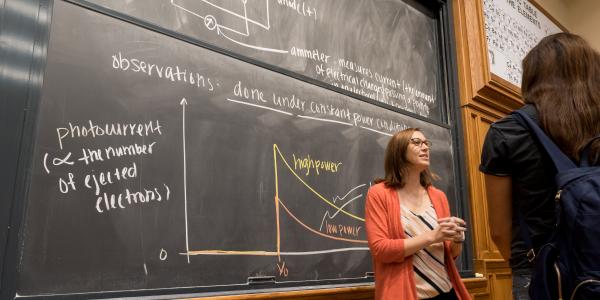The General Chemistry sequence (111A/112A) is recommended for students who have taken AP Chemistry or two years of chemistry in high school OR students who have taken one year of chemistry and one year of physics in high school.
General Chemistry I (111A)
In the early 1900s, the periodic table of the elements hung in laboratories and classrooms around the world, nearly as it appears today, and no one could explain why it was arranged as it was. That explanation required the discovery of the mysterious, dual wave-particle behavior of the electron, which forms the basis for most of modern chemistry. This course traces the story of the electron and the strange behavior resulting from its dual wave-particle character – from free electrons, to electrons in atoms, to electrons in molecules. The electron and its properties will be shown to be responsible for atomic structure, atomic orbitals, atomic spectroscopy, chemical periodicity, the arrangement of the periodic table, chemical bonding, molecular geometry, and intermolecular forces. Students will achieve a strong foundation in molecular structure, chemical bonding, and introductory quantum mechanics.
Prerequisite skills:
- Proficiency in algebra and trigonometry
- Proficiency with simple quantitative word problem solving
- Proficiency with unit analysis
Knowledge-based prerequisites:
- Familiarity with kinetic energy, potential energy, forces (F = ma), velocity, and a conceptual idea of momentum
- Understanding of vectors and how to graph them
General Chemistry II (112A)
This course covers chemical equilibrium, thermodynamics, and kinetics, and their roles in describing and determining chemical processes. The key concepts of chemical equilibrium for gas-phase reactions, heterogeneous (multi-phase) reactions, acid-base reactions, and solubility equilibria are introduced first. The next section of the course describes chemical thermodynamics with a focus on heat, work, internal energy, enthalpy, entropy, and Gibbs free energy. Key connections are made between equilibrium and thermodynamics, and students learn how to predict the spontaneous direction of a reaction from thermodynamic data, as well as being introduced to phase diagrams, fractional distillation, and colligative properties. Electrochemistry – the study of the interconversion of chemical and electrochemical energy – is presented as a practical application of thermodynamics. Chemical kinetics is the final topic, with a focus on the factors that influence the rate of a chemical reaction. The content is similar to that in Chem 106, but with a strong emphasis on advanced applications.
Prerequisite skills:
- Proficiency in algebraic manipulation of equations and relationships
- Proficiency with simple quantitative, multi-step word problem solving
- Proficiency with unit analysis
- Understanding of how to interpret graphical data and information
- Familiarity with integrals and derivatives
Knowledge-based prerequisites:
- Proficiency with (1) stoichiometry, balancing chemical equations, determining the limiting reagent; (2) compounds, chemical formulas; (3) unit conversions, including grams to moles; (4) determining molarity and dilution calculations; (5) states of matter; (6) fundamental acid/base reactions in water; (7) writing net ionic equations; and (8) balancing redox reactions
- Familiarity with (1) mechanical energy and work (force × distance); (2) thermal energy and heat; and (3) the ideal gas law and Dalton’s law of partial pressures

